
The title, "60 Second Brioche" (pronounced BREE-ohsh) comes from the article title as it appeared in Bon Appetit Magazine. While it takes a few minutes to prepare the ingredients, it does indeed come together in about sixty seconds in the food processor, making it the fastest brioche around.
In my first book, "The New Pastry Cook", the theme was to take a basic dough and make 10 to 12 items using that dough. When I first started learning to make the classic doughs I thought it a shame to spend the time to learn them and then use them for just one or two things. In the Bon Appetit article, they used the 11 recipes I developed for my book and an additional one I developed for them as they wanted an even dozen.
I learned to make many of the traditional French pastries from Andre Gotti, a marvelous French pastry chef. After I learned the traditional method, I became a consultant to Cuisinart specializing in pastry using the food processor. I modernized many of the traditional French techniques without sacrificing quality. Brioche was among them.
Whenever a dough has a lot of eggs, butter or sugar, a sponge is often used to increase the amount of yeast going into the dough. So it is with brioche which contains a lot of eggs and butter. The sponge for this is a mini dough made of the yeast, a small amount of water, a pinch of sugar and a bit of flour that is taken from the main amount used in the recipe. These are stirred together, covered and allowed to double in bulk before using. This happens quickly, usually 15 to 20 minutes which is why you make it first.
I have seen brioche that is bread like and brioche that is cake like. This brioche has a fine, cake like texture that I love. After mixing, it is more of a batter than a dough and must be refrigerated to be able to handle it. I always make it the day before, let it rise, punch it down and refrigerate it up to 3 days before using it.
While the most recognizable shape is the brioche à tête, which means "brioche with a head", it is a basic dough that can be used for so much more. Sausage or other items are sometimes encased in brioche. But that is as far as it goes. Here we use it for the Glazed Lemon Twists which is an elegant coffeecake.
While I use the processor method for home use, we used the mixer, with the same ingredients, at the bakery where we made it in much bigger batches. I am including the mixer version also.
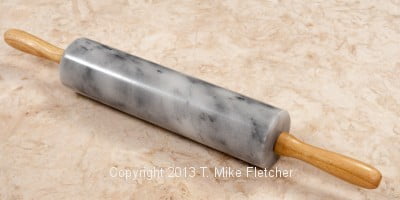
Brioche can be tricky to shape or roll out because of the large amount of butter. The butter can soften fairly quickly. If it does, transfer the dough to the refrigerator or freezer to firm up again. If you have a surface on which to roll that is not wood, ice it down before rolling the dough out. Simply dump ice cubes on it, let it stand for several minutes, remove the ice, dry the surface and roll the dough. I also use a marble rolling pin that I can chill in the freezer before rolling out the dough.I place it in the freezer for about an hour before using it. It stays cold for at least an hour. Make sure to wipe it from time to time as it will condensate after removing from the freezer.
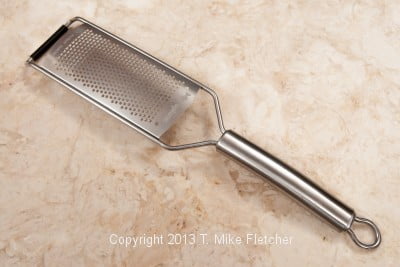
Another of my favorite tools I use in this blog is the microplaner. I don't know how I baked without it.
The Lemon Twists is a great coffee cake that can be assembled the day before and baked off in the morning or it can be baked without the glaze and rewarmed in the morning then glazed. In any case it is a wonderfully different coffeecake that highlights the adaptability of brioche.
Not only is there a lemon sugar inside, there is a great lemon glaze on the outside that shines like lacquer. So grab your processor and rolling pin and you can have this brioche coffeecake in no time.
Brioche

Start this the day before you want to use it. It may be refrigerated for several days before using if desired.
1 ½ teaspoons instant yeast
2 tablespoons warm water (105 to 115 degrees)
Pinch of sugar
2 ¼ cups bread flour (315 grams or 11 ounces)
1 ½ tablespoons sugar
½ teaspoon salt
¾ cup unsalted butter, refrigerated (170 grams or 6 ounces or 1 ½ sticks)
3 eggs, room temperature
¼ cup light cream or half and half, room temperature

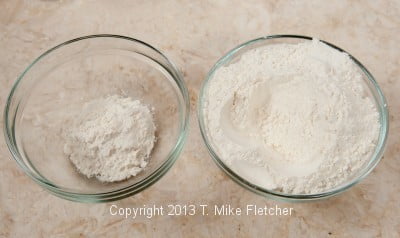
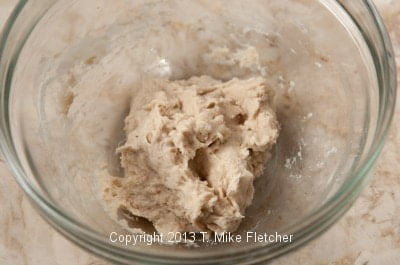


In a small bowl, add the yeast to the water. Stir it in and let it dissolve for a few minutes.Make a sponge by adding 3 tablespoons flour from the total amount of measured flour and the pinch of sugar. Stir well and cover with film. Let double in bulk, about 15 to 20 minutes.






In the processor bowl fitted with the steel blade, place the remaining flour and the salt and sugar. Process 5 seconds to mix. Cut the cold butter into ¾ inch slices and place in a circle over the dry ingredients. Process until the butter is indistinguishable in the mixture, about 20 seconds. Scrape down and process 5 seconds more. Place the eggs in a circle over the dry ingredients, pour the cream over the eggs, and add the sponge, also in a circle. Process approximately 20 to 25 seconds until the ball which initially forms breaks down into a creamy, evenly dispersed batter in the processor bowl. Do not stop processing until the is batter is formed, as the motor may stall when you try to restart it.

The batter will be very sticky and that is as it should be. Remove from the processor bowl and place in an ungreased bowl. The batter has very little elasticity and is easily managed with a large plastic pastry scraper.

Getting all the dough out of the processor bowl is easy. Remove as much as you can get out easily from the bowl. Don't try to get it off the blade. Place the bowl back on the processor with the blade in place if you have removed it. Pulse it several times. The centrifugal force will throw the dough to the sides of the bowl. Remove the blade and scrape out the additional dough.


Cover securely with plastic wrap and allow to rise until double in bulk about 2 to 2 ½ hours. Stir down and refrigerate overnight. It may or may not rise again and that is fine. Punch down and use as directed.
Mixer Method for Brioche
For this version have the butter at room temperature. Make the sponge as called for. Place the dry ingredients in the mixing bowl and mix briefly to combine them. Add the eggs, sponge and half and half and beat until a smooth dough comes together. Add the butter about a tablespoon at a time, beating until it is absorbed before adding another tablespoon. Continue as above.

Glazed Lemon Twists with Brioche
½ cup sugar
Zest from 1 medium lemon
3 tablespoons butter
1 recipe brioche
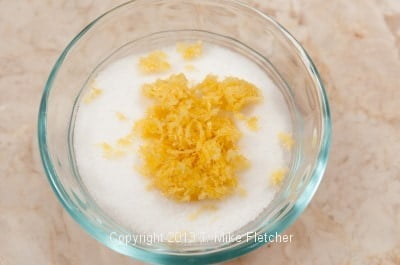
Combine the sugar and the lemon thoroughly. Set aside.

Roll the dough on a lightly floured surface to a 13 ½" x 14" rectangle.


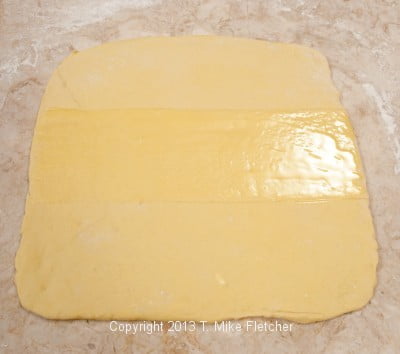





In from the 13 ½" side, lightly mark three 4 ½" strips. Brush the center strip with butter and spread half the lemon sugar evenly over the butter. Bring the bottom strip up to cover the center strip and butter and apply the lemon sugar again. Bring the top third of the dough down to cover the lemon sugar mixture. You will have a 4 ½" x 14" rectangle.
Place it in the freezer to chill. It should be firm but not hard.

Spray a 9" square pan and set aside.
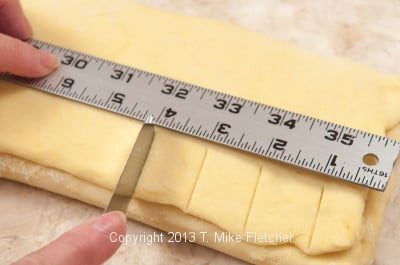




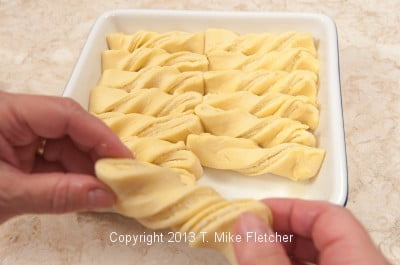

Remove the lemon twists from the freezer and cut crosswise into 14 one inch strips. Take one strip and hold one end in each hand. Twist twice by rotating your hands in opposite directions. Place 7 strips on one side of the pan and 7 on the other, touching in the middle. They will be a tight fit.
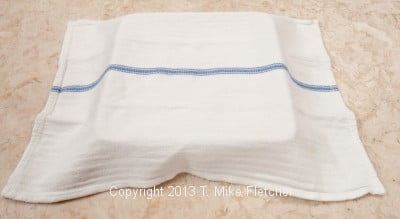
Cover with a towel and let rise until doubled, about 2 to 2 ½ hours.
Preheat the oven to 350 degrees or 325 if using a glass or dark pan. Bake for 30 to 35 minutes until deep golden brown. Place foil loosely over the top if the twists are browning too quickly. Immediately upon removing from the oven pour the lemon glaze over the twists.

Lemon Glaze
½ cup sugar (100 grams or 3 ½ ounces)
¼ cup freshly squeezed lemon juice
3 tablespoons butter



Just before the Lemon Twists are done baking, combine all together in a small saucepan and bring to a boil.

To Make Ahead: Bake the rolls as called for but do not apply the glaze. Cool completely in the pan, wrap and freeze up to 3 months. When ready to use, defrost on a rack. Heat for 15 to 20 minutes at 350 degrees. Make the glaze and pour it on as soon as the twists core from the oven.





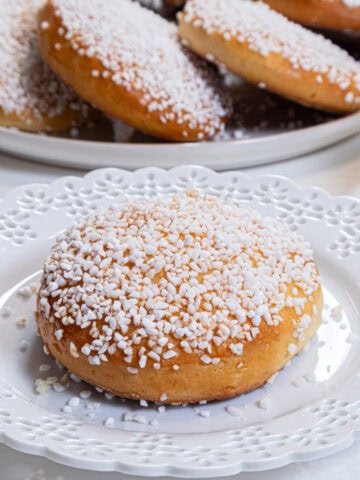


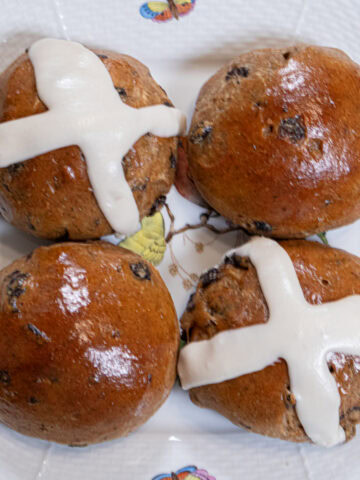
angelina says
I love learning all the wonderful pastry recipes from you. I admit that I am old school and like having printed versions of recipes that I trust in my binders. Is there a way that I cold print this recipe and many of the others that I want to try? Thank yo for sharing your knowledge with us.
Helen S Fletcher says
Hi Angelina, Thank you for your kind words. There is a button on the bottom of the recipes without recipe cards to print the recipe. However, it sometimes works and sometimes doesn't. The second option is to copy the entire recipe, paste it to word or whatever you use, delete all the photos and the heading if you like, then print the recipe. There isn't a good option for these recipes. I am working to get them into the new format but I have over 400 to change.
angelina says
Thank you
Mari gold says
I will make before Jewish holiday, be great for break the fast. Have you done ahead and frozen? Either frozen before baking or after? I have so many recipes, but eagerly wait what you are coming up with next to try a newby. Our humidity is high inflorida, there are things I can not do, sponge candy, but St. Louis is humid I know. Mari
hfletcher says
Yes this can be frozen. You can bake it and freeze it without the glaze. Directions are on the bottom of the recipe. You will thaw it, heat it briefly in the oven to warm it and then apply the glaze.
Our weather has been good for a St. Louis summer. Hope it continues.
Thanks so much for the kind comments.
manisha says
Amazing! !!! Cannot wait to make it. Helen there are thousands of recipes online but there only a few like yours bcoz they work! And your years of wisdom and methodology is a bonus with each recipe :)
hfletcher says
Hi Manisha: Thank you so much. It's all about sharing with people who enjoy baking and pastry as much as I do.